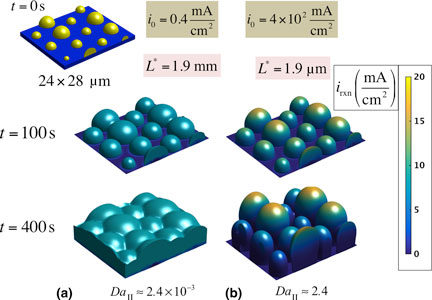Crossref Citations
This article has been cited by the following publications. This list is generated based on data provided by
Crossref.
Yurkiv, Vitaliy
Foroozan, Tara
Ramasubramanian, Ajaykrishna
Shahbazian-Yassar, Reza
and
Mashayek, Farzad
2018.
The influence of stress field on Li electrodeposition in Li-metal battery.
MRS Communications,
Vol. 8,
Issue. 3,
p.
1285.
DeWitt, Stephen
and
Thornton, Katsuyo
2018.
Computational Materials System Design.
p.
67.
Chadwick, Alexander F.
Stewart, James A.
Enrique, Raúl A.
Du, Sicen
and
Thornton, Katsuyo
2018.
Numerical Modeling of Localized Corrosion Using Phase-Field and Smoothed Boundary Methods.
Journal of The Electrochemical Society,
Vol. 165,
Issue. 10,
p.
C633.
Nagy, Kyle S.
Kazemiabnavi, Saeed
Thornton, Katsuyo
and
Siegel, Donald J.
2019.
Thermodynamic Overpotentials and Nucleation Rates for Electrodeposition on Metal Anodes.
ACS Applied Materials & Interfaces,
Vol. 11,
Issue. 8,
p.
7954.
Zheng, Jingxu
Kim, Mun Sek
Tu, Zhengyuan
Choudhury, Snehashis
Tang, Tian
and
Archer, Lynden A.
2020.
Regulating electrodeposition morphology of lithium: towards commercially relevant secondary Li metal batteries.
Chemical Society Reviews,
Vol. 49,
Issue. 9,
p.
2701.
Wang, Qiao
Zhang, Geng
Li, Yajie
Hong, Zijian
Wang, Da
and
Shi, Siqi
2020.
Application of phase-field method in rechargeable batteries.
npj Computational Materials,
Vol. 6,
Issue. 1,
Kong, Xian
Rudnicki, Paul E.
Choudhury, Snehashis
Bao, Zhenan
and
Qin, Jian
2020.
Dendrite Suppression by a Polymer Coating: A Coarse‐Grained Molecular Study.
Advanced Functional Materials,
Vol. 30,
Issue. 15,
Hong, Zijian
Ahmad, Zeeshan
and
Viswanathan, Venkatasubramanian
2020.
Design Principles for Dendrite Suppression with Porous Polymer/Aqueous Solution Hybrid Electrolyte for Zn Metal Anodes.
ACS Energy Letters,
Vol. 5,
Issue. 8,
p.
2466.
Zheng, Jingxu
and
Archer, Lynden A.
2021.
Controlling electrochemical growth of metallic zinc electrodes: Toward affordable rechargeable energy storage systems.
Science Advances,
Vol. 7,
Issue. 2,
Stalin, Sanjuna
Chen, Pengyu
Li, Gaojin
Deng, Yue
Rouse, Zachary
Cheng, Yifan
Zhang, Zheyuan
Biswal, Prayag
Jin, Shuo
Baker, Shefford P.
Yang, Rong
and
Archer, Lynden A.
2021.
Ultrathin zwitterionic polymeric interphases for stable lithium metal anodes.
Matter,
Vol. 4,
Issue. 11,
p.
3753.
Gopalakrishnan, Sarathy K.
Ganesh, Akash
Wang, Chun-Chieh
Mango, Matthew
Ziegler, Kirk J.
and
Narayanan, Ranga
2021.
Isolation of competing morphological patterns during microfluidic electrodeposition: Experimental confirmation of theory.
Electrochimica Acta,
Vol. 398,
Issue. ,
p.
139205.
Ganesh, Akash
Pillai, Dipin S.
and
Narayanan, R.
2022.
Effect of low-frequency AC forcing on the morphological instability arising in electrodeposition.
Journal of Engineering Mathematics,
Vol. 132,
Issue. 1,
Goel, Vishwas
Lyu, Yanjun
DeWitt, Stephen
Montiel, David
and
Thornton, Katsuyo
2022.
Simulating microgalvanic corrosion in alloys using the PRISMS phase-field framework.
MRS Communications,
Vol. 12,
Issue. 6,
p.
1050.
Zhang, Shu
Ma, Jun
Dong, Shanmu
and
Cui, Guanglei
2023.
Designing All-Solid-State Batteries by Theoretical Computation: A Review.
Electrochemical Energy Reviews,
Vol. 6,
Issue. 1,
Amir Masoud Behagh
and
Alireza Fadaei Tehrani
2023.
Investigation and Modelling of Copper Electroforming Process for Surface Roughness Parameters Using Regression and Pareto ANOVA Analyses.
Surface Engineering and Applied Electrochemistry,
Vol. 59,
Issue. 6,
p.
780.
Choudhury, Snehashis
Huang, Zhuojun
Amanchukwu, Chibueze V.
Rudnicki, Paul E.
Chen, Yuelang
Boyle, David Thomas
Qin, Jian
Cui, Yi
and
Bao, Zhenan
2023.
Ion Conducting Polymer Interfaces for Lithium Metal Anodes: Impact on the Electrodeposition Kinetics.
Advanced Energy Materials,
Vol. 13,
Issue. 35,
Goel, Vishwas
Chen, Kuan-Hung
Dasgupta, Neil P.
and
Thornton, Katsuyo
2023.
Optimization of laser-patterned electrode architectures for fast charging of Li-ion batteries using simulations parameterized by machine learning.
Energy Storage Materials,
Vol. 57,
Issue. ,
p.
44.
Monti, Joseph M.
Stewart, James A.
Custer, Joyce O.
Adams, David P.
Depla, Diederik
and
Dingreville, Rémi
2023.
Linking simulated polycrystalline thin film microstructures to physical vapor deposition conditions.
Acta Materialia,
Vol. 245,
Issue. ,
p.
118581.
Ju, Zhengyu
Zheng, Tianrui
Zhang, Bowen
and
Yu, Guihua
2024.
Interfacial chemistry in multivalent aqueous batteries: fundamentals, challenges, and advances.
Chemical Society Reviews,
Vol. 53,
Issue. 18,
p.
8980.
Dutta, Arghya
2024.
Dynamic Processes at the Electrode‐Electrolyte Interface: Implications for Lithium Deposition Stability.
ChemElectroChem,
Vol. 11,
Issue. 23,


